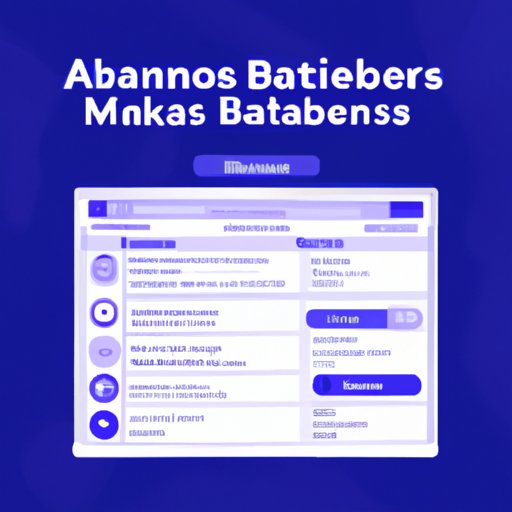Introduction
Facebook Business Manager is a powerful tool that allows businesses to manage their presence on the platform. It provides a centralized hub for managing multiple ad accounts, Pages, and other assets. With Facebook Business Manager, you can easily invite other users to access and manage your assets, set up different roles and permissions, and customize settings.
In this article, we’ll look at how to add someone to your Facebook Business Manager. We’ll cover how to create a Business Manager, invite users, assign roles and permissions, add Pages and ad accounts, connect payment methods, and customize settings.

Create a Business Manager Account
Before you can add someone to your Business Manager, you need to create one. To do this, go to business.facebook.com and click “Create Account”. You’ll then be asked to enter your name, email address, and phone number. Once you’ve done this, you’ll be taken to the main Business Manager dashboard.
It’s important to note that you don’t have to use your personal Facebook account to create a Business Manager. You can create a separate account specifically for managing your business. This will help keep your personal and business activities separate.
Managing Multiple Ad Accounts
One of the benefits of using Facebook Business Manager is that it allows you to manage multiple ad accounts in one place. To do this, click on the “Ad Accounts” tab on the left-hand side of the dashboard. Here, you can add existing ad accounts or create new ones.
If you’re managing multiple ad accounts, it’s important to have a consistent naming convention so that you can easily keep track of them. For example, you could name each account after the product or service it’s promoting, such as “Product A Ad Account” or “Service B Ad Account”.
Invite Users to the Business Manager
Once you’ve created your Business Manager and added any ad accounts, you can start inviting users. To do this, click on the “People and Assets” tab on the left-hand side of the dashboard. Here, you’ll see the option to “Add People”. Click this to open the invitation window.
Types of Users
When you invite someone to your Business Manager, you can choose from four different types of users: Admin, Employee, Partner, and System User. Each type has its own set of permissions and access levels.
For example, an Admin has full control over all aspects of the Business Manager, including setting up and managing ad accounts, assigning user roles, and customizing settings. An Employee has more limited access, such as the ability to view reports and create ads.
It’s important to understand the different roles and permissions before inviting someone to your Business Manager. That way, you can ensure they have the right level of access for their role.

Inviting Users to Your Business Manager
Once you’ve chosen the type of user you want to add, you can invite them by entering their email address. You can also add additional information, such as their job title and a message. Then, click “Send Invitation” to send the invitation.
The person you invited will then receive an email with a link to accept the invitation. Once they click the link, they’ll be able to access the Business Manager. It’s important to note that they won’t have access to any of your assets until you assign them a role and permissions.
Assign Roles and Permissions
Once someone has accepted your invitation, you can assign them a role and set their permissions. To do this, go to the “People and Assets” tab and select the user you want to assign a role to. Then, click “Edit Role” and select the role you want to assign. You can also customize their permissions by selecting the checkboxes next to the assets you want them to have access to.

Understanding Different Roles and Permissions
It’s important to understand the different roles and permissions before assigning them to someone. According to a study by HubSpot, “The most important thing to remember when assigning roles is that each role has different levels of access and privileges. Make sure you understand what those levels are before assigning any roles.”
For example, an Admin has full control over all aspects of the Business Manager, while an Employee only has access to certain features, such as viewing reports and creating ads. Understanding the different roles and permissions will help you ensure that the people you’re inviting have the right level of access for their role.
Add Pages, Ad Accounts, and Other Assets
Once you’ve assigned roles and permissions to your users, you can start adding Pages, ad accounts, and other assets. To do this, go to the “Assets” tab on the left-hand side of the dashboard. Here, you can add existing Pages and ad accounts, or create new ones.
Adding Pages and Ad Accounts
To add an existing Page or ad account, click “Add” and search for the asset you want to add. Once you’ve found it, click “Add” to add it to your Business Manager. You can repeat this process for any other Pages or ad accounts you want to add.
Adding Other Assets
You can also add other assets, such as pixels and product catalogs. To do this, click “Add” and select the asset you want to add. You’ll then be asked to provide some information about the asset, such as its name and URL. Once you’ve done this, click “Add” to add the asset to your Business Manager.
Connect Payment Methods
Once you’ve added all the assets you want to your Business Manager, you can connect a payment method. To do this, go to the “Payments” tab on the left-hand side of the dashboard. Here, you can link your credit card or PayPal account to pay for any ads you run.
Linking Your Payment Method
To link your payment method, click “Link Payment Method” and select either “Credit Card” or “PayPal”. You’ll then be asked to enter your payment details. Once you’ve done this, click “Link Payment Method” to link the payment method to your Business Manager.
Setting Up Automatic Payments
You can also set up automatic payments, which will automatically charge your linked payment method whenever you run an ad. To do this, click “Settings” and select “Automatic Payments”. Then, select the payment method you want to use and click “Save” to enable automatic payments.
Customize Your Settings
Finally, you can customize your settings to ensure that your Business Manager is secure and compliant. To do this, go to the “Settings” tab on the left-hand side of the dashboard. Here, you can customize privacy settings, such as who can view your assets, and other settings, such as whether users need to request access to certain assets.
Customizing Privacy Settings
It’s important to customize your privacy settings to ensure that only authorized users have access to your assets. To do this, click “Privacy Settings” and select the settings you want to customize. For example, you can choose whether users need to request access to certain assets, or if they can access them automatically.
Customizing Other Settings
You can also customize other settings, such as whether users can delete assets or run ads. To do this, click “Other Settings” and select the settings you want to customize. For example, you can choose whether users can delete assets or run ads without approval.
Conclusion
Adding someone to your Facebook Business Manager is a great way to manage multiple ad accounts, Pages, and other assets in one place. In this article, we looked at how to add someone to your Business Manager, including creating a Business Manager, inviting users, assigning roles and permissions, adding assets, connecting payment methods, and customizing settings.
By following the steps outlined in this article, you can ensure that your Business Manager is secure and compliant, and that your users have the right level of access for their role.
Summary
Facebook Business Manager is a powerful tool that allows businesses to manage their presence on the platform. It provides a centralized hub for managing multiple ad accounts, Pages, and other assets. In this article, we looked at how to add someone to your Business Manager, including creating a Business Manager, inviting users, assigning roles and permissions, adding assets, connecting payment methods, and customizing settings.
Resources
https://www.hubspot.com/facebook-business-manager
(Note: Is this article not meeting your expectations? Do you have knowledge or insights to share? Unlock new opportunities and expand your reach by joining our authors team. Click Registration to join us and share your expertise with our readers.)
